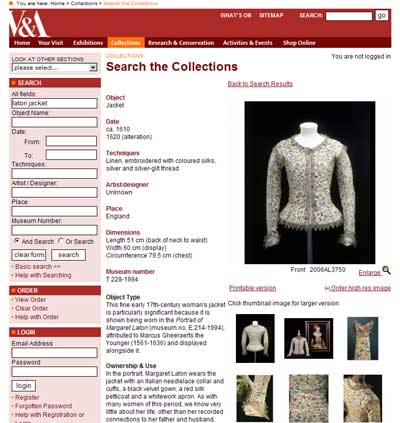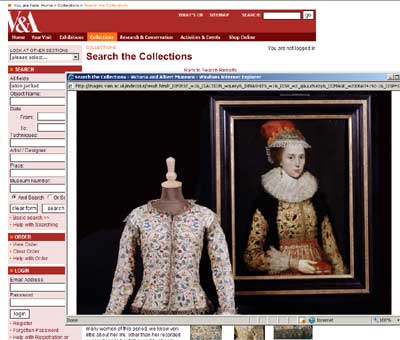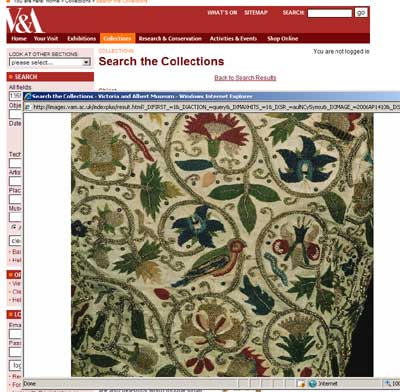…but not by me! If you are interested in embroidery (historical or otherwise), costuming, or textiles in general, you might enjoy looking into this fascinating project underway at Plimoth Plantation.
In November of 2006, the Colonial Wardrobe & Textiles Department at Plimoth Plantation conceived the plan to re-create a piece of 17th century clothing to display in an upcoming exhibit highlighting the “personal adornment” of folks way back in the 1600’s.
The plan developed into creating, entirely by hand, a faithful reproduction of a 17th century embroidered jacket. After much research and fine-tuning, the folks at Plimoth Plantation put the plan in action, inviting embroiderers from all over to participate in the work. And what a work!
They have been faithfully blogging the process since May, 2007, and their blog, The Embroiderers’ Story, is full of fascinating reading and delightful images, inspiring to anyone interested in historical needlework. (Update, 2017: the original blog that recorded this project is now defunct.)
It is a story, really, of seeking and discovery, driven by the motivated members of the textile department at Plimoth Plantation. To follow the progress from its beginning to now, visit the May archives of the Embroiderers’ Story and scroll to the bottom of the page here.
The post titled “In the Beginning” sets the stage for the rest of the story.

The pattern for the body of the embroidered jacket is the Laton Jacket, on display at the Victoria and Albert Museum in London, which they have “cross referenced” with another jacket at the museum, item 1359-1900 (at the V&A;).

The second jacket is the one from which they adapted the embroidery design. It’s very pretty!

The textile department made up sample embroidery kits which were made available to embroiderers from all over, the costs of which helped finance the project. Taking the samples that were worked and sent back to them, the textile department matched up embroiderers of similar skills to work together on the jacket. The embroiderers meet at the Plimoth Plantation and work on the jacket.
Some excellent pictures of the nature and progress of the work can be found on flickr, where one of the embroiderers has posted heaps of pictures from her visit to Plimoth Plantation to work on the jacket.
You can see some gorgeous close-ups of the embroidery, as well as some great shots of the whole work set-up at the Plantation.
The predominant stitch used on the jacket seems to be buttonhole filling, worked inside a foundation of reversed chain. In addition, there’s a swirling motif of what looks like braid stitch worked in gold thread. A little trim of metal bobbin lace tipped with spangles adorns the jacket, and spangles speckle the whole jacket – some 2,000 of them!







How fascinating! As a lover of historical needlework I will be poring over the info at your link.
Thomasina Beck has a few wonderful historical needlework books out, one of which is titled “The Embroiderer’s Story” I have spent literally hours taking in the sumptuous pictures and authoritative text. I believe the jacket is featured in that book.
I have been following this project with great interest … even purchasing the sample kit (although I have not finished stitching it and so have not sent it back). This project, with regards to how difficult it is to find certain supplies, is a prime example of if we don’t continue to purchase these high quality items (fibers, linens, etc.) the production of them will cease. Tricia Wilson Nguyen, in my opinion, is doing some of the most important and impressive work to keep the needlearts alive. She was instrumental (along with Lamora Hadar of Access Commodities) to having the Gilt Sylke Twist thread (used on this project) reproduced.
It is fascinating, isn’t it?? I’ve been pouring over the Embroiderers’ Story blog for hours, reading all the posts and lingering over the photos! It’s an amazing work, and the folks at Plimoth Plantation deserve heaps of praise for undertaking it.
JC, I’d love to be able to work on the project! You’re really lucky! And I’d love to see the gilt sylke twist upclose and try it. Is it a “specialty item” just for this project, or is it something available on the market for others as well? Anyone know? It looks like beautiful thread!
Regarding the availability of the Gilt Sylke Twist, it is my understanding that it will eventually be made available to the general public. Tricia Wilson Nguyen will be teaching in February in Williamsburg. In one of her classes, she will be introducing this newly reproduced fiber.
How exciting!! Thanks, JC, for the news!
I can’t wait to get my hands on the gilt sylke twist. There was a close-up photo of it on the site.